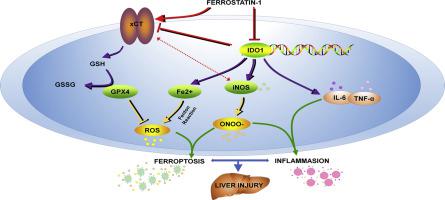当前位置:
X-MOL 学术
›
Free Radical Bio. Med.
›
论文详情
Our official English website, www.x-mol.net, welcomes your
feedback! (Note: you will need to create a separate account there.)
Indoleamine 2, 3-dioxygenase 1enhanceshepatocytes ferroptosis in acute immune hepatitis associated with excess nitrative stress.
Free Radical Biology and Medicine ( IF 7.1 ) Pub Date : 2020-01-13 , DOI: 10.1016/j.freeradbiomed.2020.01.009 Ting Zeng 1 , Guanghui Deng 1 , Weichao Zhong 2 , Zhuowei Gao 1 , Shuoyi Ma 3 , Chan Mo 1 , Yunjia Li 1 , Sha Huang 1 , Chuying Zhou 1 , Yuqi Lai 1 , Shuwen Xie 1 , Zeping Xie 1 , Yuyao Chen 1 , Songqi He 1 , Zhiping Lv 1 , Lei Gao 1
Free Radical Biology and Medicine ( IF 7.1 ) Pub Date : 2020-01-13 , DOI: 10.1016/j.freeradbiomed.2020.01.009 Ting Zeng 1 , Guanghui Deng 1 , Weichao Zhong 2 , Zhuowei Gao 1 , Shuoyi Ma 3 , Chan Mo 1 , Yunjia Li 1 , Sha Huang 1 , Chuying Zhou 1 , Yuqi Lai 1 , Shuwen Xie 1 , Zeping Xie 1 , Yuyao Chen 1 , Songqi He 1 , Zhiping Lv 1 , Lei Gao 1
Affiliation

|
Ferroptosis is a recently recognized form of regulated cell death that is characterized by lipid peroxidation. However, the molecular mechanisms of ferroptosis in acute immune hepatitis (AIH) are largely unknown. In this study, we investigated the classical ferroptotic events in the livers of mice with concanavalin A (ConA) to induce AIH. The dramatically upregulated gene indoleamine 2, 3-dioxygenase 1 (IDO1) was identified with AIH, and its role in generation of ferroptosis and reactive nitrogen species (RNS) was assessed both in vitro and in vivo by genetic deletion or pharmacologic inhibition of IDO1. We observed that ferroptosis contributed to the ConA-induced hepatic damage, which was confirmed by the therapeutical effects of ferroptosis inhibitor (ferrostatin-1). Noteworthy, upregulation of hepatic IDO1 and nitrative stress in ConA-induced hepatic damage were also remarkably inhibited by the ferroptosis abolishment. Additionally, IDO1 deficiency contributed to ferroptosis resistance by activating solute carrier family 7 member 11 (SLC7A11; also known as xCT) expression, accompanied with the reductions of murine liver lesions and RNS. Meanwhile, IDO inhibitor 1-methyl tryptophan alleviated murine liver damage with the reduction of inducible nitric oxide synthase and 3-nitrotyrosine expression. Consistent with the results in vivo, hepatocytes-specific knockdown of IDO1 led to ferroptosis resistance upon exposure to ferroptosis-inducing compound (Erastin) in vitro, whereas IDO1 overexpression aggravated the classical ferroptotic events, and the RNS stress. Overall, these results revealed a novel molecular mechanism of ferroptosis with the key feature of nitrative stress in ConA-induced liver injury, and also identified IDO1-dependent ferroptosis as a potential target for the treatment of AIH.
中文翻译:

吲哚胺 2, 3-双加氧酶 1 增强与过度硝化应激相关的急性免疫性肝炎中的肝细胞铁死亡。
铁死亡是最近公认的一种受调节的细胞死亡形式,其特征是脂质过氧化。然而,急性免疫性肝炎(AIH)中铁死亡的分子机制在很大程度上是未知的。在这项研究中,我们研究了伴刀豆球蛋白 A (ConA) 小鼠肝脏中经典的铁死亡事件,以诱导 AIH。显着上调的吲哚胺 2, 3-双加氧酶 1 (IDO1) 基因被识别为 AIH,并通过基因缺失或 IDO1 的药理抑制在体外和体内评估了其在生成铁死亡和活性氮物种 (RNS) 中的作用。我们观察到铁死亡导致了 ConA 诱导的肝损伤,铁死亡抑制剂 (ferrostatin-1) 的治疗效果证实了这一点。值得注意的是,ConA 诱导的肝损伤中肝脏 IDO1 的上调和硝化应激也被铁死亡的消除显着抑制。此外,IDO1 缺乏通过激活溶质载体家族 7 成员 11(SLC7A11;也称为 xCT)表达,伴随着小鼠肝脏病变和 RNS 的减少,导致铁死亡抗性。同时,IDO 抑制剂 1-甲基色氨酸通过减少诱导型一氧化氮合酶和 3-硝基酪氨酸的表达来减轻小鼠肝损伤。与体内结果一致,在体外暴露于铁死亡诱导化合物(Erastin)后,肝细胞特异性 IDO1 敲低导致铁死亡抗性,而 IDO1 过表达加剧了经典的铁死亡事件和 RNS 应激。总体,
更新日期:2020-01-13
中文翻译:

吲哚胺 2, 3-双加氧酶 1 增强与过度硝化应激相关的急性免疫性肝炎中的肝细胞铁死亡。
铁死亡是最近公认的一种受调节的细胞死亡形式,其特征是脂质过氧化。然而,急性免疫性肝炎(AIH)中铁死亡的分子机制在很大程度上是未知的。在这项研究中,我们研究了伴刀豆球蛋白 A (ConA) 小鼠肝脏中经典的铁死亡事件,以诱导 AIH。显着上调的吲哚胺 2, 3-双加氧酶 1 (IDO1) 基因被识别为 AIH,并通过基因缺失或 IDO1 的药理抑制在体外和体内评估了其在生成铁死亡和活性氮物种 (RNS) 中的作用。我们观察到铁死亡导致了 ConA 诱导的肝损伤,铁死亡抑制剂 (ferrostatin-1) 的治疗效果证实了这一点。值得注意的是,ConA 诱导的肝损伤中肝脏 IDO1 的上调和硝化应激也被铁死亡的消除显着抑制。此外,IDO1 缺乏通过激活溶质载体家族 7 成员 11(SLC7A11;也称为 xCT)表达,伴随着小鼠肝脏病变和 RNS 的减少,导致铁死亡抗性。同时,IDO 抑制剂 1-甲基色氨酸通过减少诱导型一氧化氮合酶和 3-硝基酪氨酸的表达来减轻小鼠肝损伤。与体内结果一致,在体外暴露于铁死亡诱导化合物(Erastin)后,肝细胞特异性 IDO1 敲低导致铁死亡抗性,而 IDO1 过表达加剧了经典的铁死亡事件和 RNS 应激。总体,











































 京公网安备 11010802027423号
京公网安备 11010802027423号